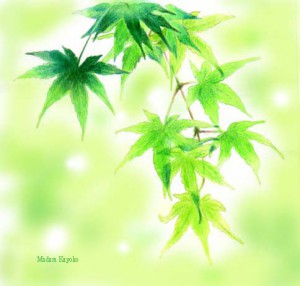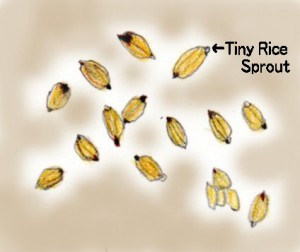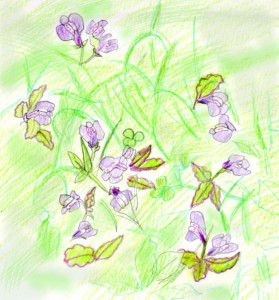My new year’s resolution is to update this blog frequently!
I hope to see you again, soon.

Whenever the season of fresh green comes around at this time of the year, trees bathed in sunlight recall me a book that influenced my life.

When I started working for a company right after graduating from college, I was always tired because I was really confused about the gap between college life and working life.
One day I was browsing a bookstore to kill time. Though I wasn’t looking for anything special, I casually stood in front of a bookshelf because one book seemed to stand out and drew me in.
So I reached out and took that book from the shelf. Its title read, “Trees Bathed in Sunlight.” I opened its cover, and once I started reading it I couldn’t stop. It was a collection of daily essays written by Japanese philosopher Arimasa Mori, who had died in Paris.
Mainly, he writes about personal experiences in the book. He says, “Experience makes you what you are.” What he wants to say is very simple; it struck me, and I got energy from his words. Since then, when I have to make a hard decision, I try to do it to gain experience.
As its title “Trees Bathed in Sunlight” suggests, the book became the sunlight of my life. This encounter changed me.
I’m very busy during spring not simply because of joining Satoyama activities but also sketching wildlife.
Recently, I often go sketching the wildflowers that have come out here and there.
I’ve walked no less than 50 kilometers since last week.
I uploaded some pictures I had sketched for the last two weeks.

↑These are rice seeds with a nity sprout.

↑ Manchurian violet
You can see them along the rice paddy fields.

↑ Oojisibari in Japanese name.
I posted a new article on my Japanese blog. Click here to see it.
About five years ago, I joined a Satoyama preserving group and started doing activities.
Satoyama means a border area between human domicile and wildlife, which is including rice paddy fields, forests and those surroundings.
Japanese people have been making full use of the geographical features in Satoyama area for a long time, in spite of its geographical disadvantages that are small, close and steep.
In Satoyama area, People have been playing an important role in wildlife conservation as well as enhancing sustainable living standards.
There are so many kind of birds, insects, flowers, trees there.
This weekend, I cannot update a long essay in this blog because I am very busy supporting for the Satoyama activities.
It is time that they started plowing rice paddy fields.
I just uploaded a drawing of bamboo sprouts which you can eat.
The world’s first novel was Genji Monogatari (“The Tale of Genji”) written by Murasakisikibu, who was a court lady about 1,000 years ago in the Heian Era. It has been translated into many languages including a famous version by Arthur David Waley, who was an English researcher on Orientalics.
Although Japanese high school students study ancient Japanese literature at school, “The Tale of Genji” is too long for them to study. It has 54 chapters, so high school students often study Makura no Soushi (“The Pillow Book of Sei Shonagon”) instead.
Sei Shounagon, the author of “The Pillow Book of Sei Shonagon” was a court lady as well. She described the change of weather during the four seasons in a colorful and lively way in her diary. In addition, one story is short enough for students to memorize. Even now, more than two decades after graduating from high school I can still recite it .
In the first part of this book, she talked about her favorite times of the four seasons, like in the following passage.
“In spring it is the dawn that is most beautiful. As the light creeps over the hills, their outlines are dyed a faint red and wisps of purplish cloud trail over them.” (Ivan Morris)
Now, I will try to describe my favorite times in English in the same way.
My favorite times of the four seasons
Although cherry blossoms symbollize Japanese spring, I think falling cherry petals seem more beautiful than cherry blossoms on the trees. Gusts of wind often occur in the middle of spring. When the wind blows the cherry petals, they fall off the branches like snow. Those subtle pink petals look especially whiter at nighttime than they do during the day. I sometimes love to stand under a big cherry tree, and I can feel like I’m taking a flower shower.
One thing I love to do in the middle of summer is to take a nap in the afternoons. I often get up earlier than usual in the morning, sometimes before dawn, and I start doing many things briskly and become soaked in sweat until around 1:00 p.m.when I eat a late lunch. Then I take a nap after taking a cold shower. I doze for more than 30 minutes, sometimes hearing a roll of thunder in the distance. If it were not for the hot summer, then taking a nap would not feel so good for me, but I don’t think human beings should make our planet any warmer.
At the beginning of September, while there may still be several hot days left, crickets start chirping. They sound like jingles and tell us that autumn has arrived, and there blows without fail a cool breeze. The daytime gets quickly shorter after the Autumnal Equinox. The cumulonimbus clouds that bring thunder disappear, and cirrocumulus clouds replace them high in the clear sky. Harvest time arrives and my huge appetite comes back. When the tree leaves turn yellow or red, the traffic toward the mountains is often jammed, so I prefer to go hiking in rural areas to see the colorful natural environment while carrying a lunch box.
At dusk in winter, in spite of the cold, I sometimes walk around the nearby park, which is lined with zelkova trees that have shed their leaves, because I like to see the black shape of their branches silhouetted against the deep cobalt-blue sky. They make very fine and intricate shapes, like lacework. Above the trees’ silhouettes in the eastern sky is the newly emerged moon. The chillier the air feels, the clearer the moon appears. That is winter.
↓translated by Ivan Morris
The other day, Yoko Ono posted on her Twitter account four antigun messages with an image of the blood-splattered glasses that Lennon was wearing when he was shot on Dec. 8, 1980.
That tweet was re-tweeted more than 3,000 times.
That news reminded me of the piano that John Lennon used to like playing during his stay in Japan.I saw it about two and an half years ago, when I went to Karuizawa, which is one of the luxury summer resorts of Japan.
It was the end of the extreme summer heat. I generally have no interest in booking a hotel room in a resort in the high season, but I had been really exhausted from an unprecedented swelter for three months.
Luckily, I could book a room in a splendid old hotel called the Manpei Hotel through its website at a good bargain price just one day before I went there.
I went there alone because my husband was very busy, but he knew that I felt really sick of the heat.
Karuizawa is very famous for the present Emperor’s love story with his wife, the Empress. It was a romantic story. He met her and fell in love with her at first sight at a tennis club’s court in Karuizawa, and they played tennis together in summer 1957.
In those days, he was Prince Akihito, the successor, and to tell the truth, his teacher, Mr. Koizumi Shinzou (who was the former president of Keio University) had managed this fateful encounter to look as if it had happened by chance, but Japanese people were excited by the story.
In 1957, Japanese people were on the road to recovery from national ruin and grief through the loss of family members during World War Ⅱ. Actually, the Emperor was considered a kind of god before World War Ⅱ, but this prince and princess story seemed to impress Japanese people as it proved that the royal family could show humanity. It must have been epoch-making for both the royal family and for Japanese society.
By the way nowadays, Karuizawa became a popular place. Although it took about 3 hours to get Karuizawa from Tokyo before, it now takes about an hour on the Nagano bullet train. Besides, many retail outlets have been opened in malls near the station, so I saw many women with big shopping bags there. As Karuizawa can offer a luxurious mood and convenient shopping places, it was crowded here and there.
The lobby and the café terrace of the Manpei Hotel looked authentic and luxurious, and were also very popular and crowded. During my stay, the hotel staff were so courteous that I felt as if I were Paris Hilton. In spite of its discount price, my room was not cheap for me but was worth paying for.
The Manpei Hotel was established as a Japanese-style inn in 1764. They changed their Japanese hospitality to a Western style in the late 1800s while Karuizawa was developing as a resort for celebrities, rich people and foreigners, and they succeeded in their business.
Many famous people stayed there one after another. John Lennon even stayed from 1976 to 1979 during summer. I saw the piano that he once played. It graced the corner of the hotel. They say that John liked playing that piano and he must have played “Imagine” with it.
Nawadays, some of his fans visit this hotel to see it.
The hotel was run as a family business until they merged with the Mori Trust financially in 1997.
Six months later I had visited Karuizawa, the devastating earthquake hit the Tohoku area and the nuclear plant building exploded, then many things changed and deteriorated.
International tension of far east Asian area built up, and some popular politicians started referring of nuclear power in Japan. Permanent peace of Japan guaranteed by the Article 9 of the Constitution is now shaking. On the other hand, school violences with guns sometimes happened in the USA as Yoko’s tweet.
You may well think that John Lennon’s “Imagine” is nothing but an illusion.
But, I think that appealing to reason is more challenging than resorting to violence. I’m on Yoko’s side and trying to do something I can do, maybe it might be mere things, for making the “Imagine” world.
I usually paint or draw my pictures or sketches in Japanese traditional pigments, Chinese ink, pencil, color pencil or watercolors. I scarcely use oil paints.
Japanese traditional pigments require gelatin as a medium to bind it to the paper. This gelatin, called “nikawa” in Japanese, also is used in art all over the world including in Chinese ink.
In Europe, artists often used nikawa to make the bases of their works by mixing it with plasters and applying it to wood and other objects instead of using canvases, until oil colors were invented. This method is called “tempera”. Many Renaissance masterpieces are made on tempera, like “The Birth of Venus” and “Primavera” by Sandro Botticelli to name a couple. Nowadays, some artists still intentionally work with tempera for their pieces.
Anyway, nikawa is an ocher-colored solid substance that looks like amber, and consists of a sort of protein that you get after boiling fish or animal bones, cooling the residue and finally drying it out to make it solid. Before the moisture has completely evaporated from nikawa, the substance is tender like jellyfish and you can eat it. This nikawa, we call nikogori, and Japanese izakaya bars often serve nikogori to their customers. It is delicious and healthy because it contains no fat but is high in protein.
To produce Chinese ink, nikawa is mixed with soot that you get after burning pine pitch and kneading them together for a long time, until they form a solid. To draw in Chinese ink, you need to pour a little water on a rock, called suzuri, while rubbing a piece of solid Chinese ink cake on it for over ten minutes, then you can get a wide range of graduation in monochrome.
The general term applied to Japanese traditional pigments is iwa-enogu. Iwa means “rock,” and enogu means “pigment.” This is because ancient Japanese people ground colored rocks to use them for pigments when painting pictures. Nowadays, natural pigments are too expensive for me to paint in, so I use cheaper chemical-made pigments. Painting in iwa-enogu involves soaking nikawa in water in a small bottle for two hours and heating it while it melts, then mixing it with the various pigments.
Chinese ink and Japanese iwa-enogu are both difficult to use, while Western watercolors are easy because they are packed in tubes. Western watercolors are made with Arabic gum.
Despite their inconvenience for painting, for me, Chinese ink and Japanese iwa-enogu feel more powerful than watercolors. For this reason, I usually decide which one to use depending on the kind of work I’m painting.
Each material has its own advantages and disadvantages.
Oil colors are sleek, bright, and easy to use. But it takes a week to dry and it smells bad during the evaporation process. Acrylic resin was invented in the beginning of the 20th century. It looks like oil colors and is easy to use with water, what’s more, it scarcely smells. Recently I use acrylic resin from time to time for my works.
By the way, have you ever wondered where Japanese color names come from? Are there any differences between English and Japanese color names? Both stem from natural things such as flowers and birds, but there are differences in how they are named. For example, deep-purple/pink is called fuchsia in English, and botan-iro, which means “a color like peony petals,” in Japanese. In Japanese, iro means color. Grayish pale pink is called salmon pink in English and toki-iro in Japanese. Toki means “ibis” in Japanese – a bird whose feathers are partially pale pink. Although toki used to be common in rice fields all over Japan, the native Japanese variety is now unfortunately extinct because it was averse to agrichemicals. All tokis in Japan now originate from China.
In addition, many Japanese kids these days seem to use English names when referring to colors. They never say toki-iro instead of pink. I suspect that, like the toki, Japanese color names are also endangered.
My Japanese Blog is here to see click!
So far I have had four female cats .
I currently have two young female cats, “Sister” and “Kitten”.
In this week’s blog I will be talking about two previous cats of mine.
I will call them “Grand-ma” and “Aunt” in this article, because I sometimes use their real names as password or something.
The characters and appearances of the two cats were quite different, as were their births.
Grand-ma was the first cat that I decided to take care of by myself.
She was born in a veterinarian’s house; she was calm and friendly, prefered to be with family members, and was a very beautiful tabby.
Conversely, I heard that Aunt had been left with her brothers and sisters in an abandoned cardboard box in an empty lot, and she was almost not saved because of her dirty appearance.
When Aunt came to my house, Grand-ma had already lived with us for 16 months. Grand-ma welcomed Aunt, but Aunt didn’t become tame at all for the first three months. Whenever our family members or Grand-ma tried to approach her, she always refused our advances.
Although all of us, including Grand-ma loved Aunt, it took about two years until Aunt became tame. What’s more, she still preferred to be alone, and was always searching for places where she could hide.
However, both of them were generally on good terms as you can see in this picture.
Grand-ma died two years ago when she was 17 years old, after giving us many years of love. Then Aunt began to refuse us again.
We realized that Grand-ma had protected a buffer between Aunt and us.
So we decided to leave Aunt alone in the corner of the house with food and clean toilet box. She seemed to be easy and secure.
My husband soon began to miss having an affectionate cat around. He started talking about how compassionate Grand-ma had been, and often bothering me when I was trying to work.
I began to look for a stray cat while I was walking, because I was certain that my husband needed a new cat.
Then, it happened by accident one night. I encountered “Sister” near my house during my walk. I immediately talked to my husband over my cellular phone, and he soon showed up to meet her with a carry box in his hand .
Marvelously,the week after Sister came to my house, Aunt passed away peacefully in her sleep.
10 month later, “Kitten” came to my house.
Now I have two young cats “Sister” and “Kitten”.
They eat, run and sleep very well every day.
They are happy and so are my husband and I.
I think the legend is true. It is cats who choose their owners, not owners who choose their cats.